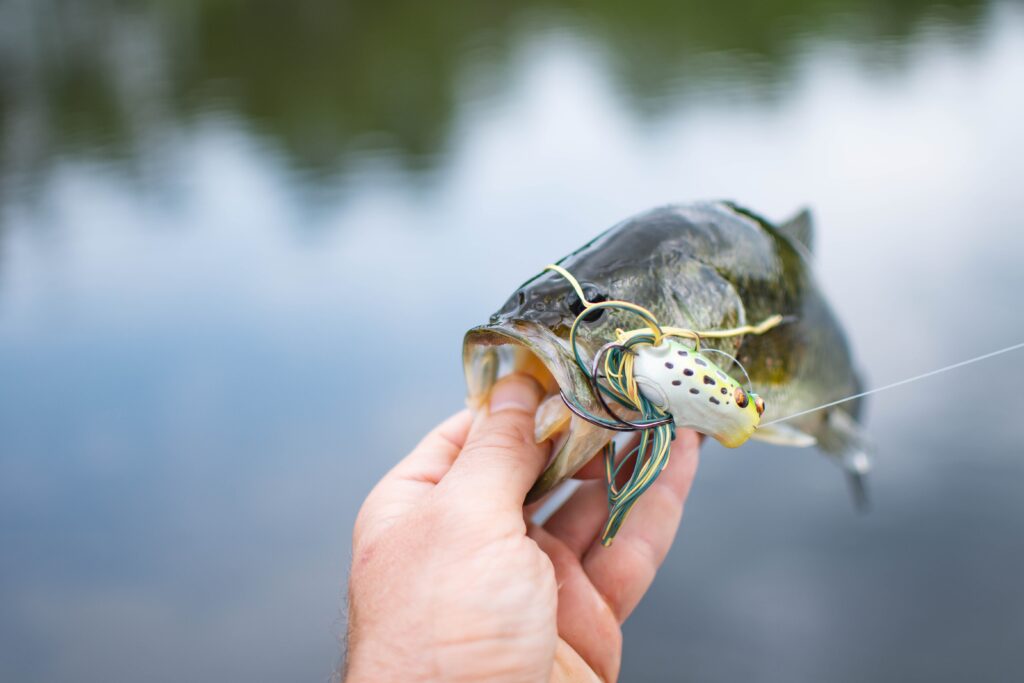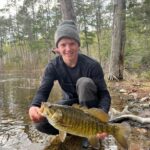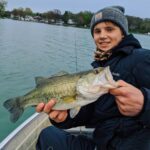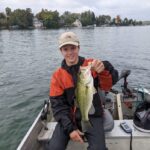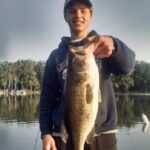Hey there anglers! If you’re anything like me, you know there is something special about topwater bass fishing. It’s that suspense before the water erupts and you’ve got them hooked. There are a few important things that every angler should know when it comes to this technique and a few nuances that will help improve your success on the water. Whether you’re a seasoned pro or just starting out, this guide to topwater bass fishing has got you covered.
As always, fishing education and conservation are our priorities here at The Angler’s Line. Feel free to sign up for our free newsletter to join our community and stay up to date! Lets get started!
Table Of Contents:
- Understanding Topwater Bass Fishing
- When Should You Use Topwater?
- Gear
- Lures
- Retrieves
- Location
- Lake Specifics
- Conservation
Understanding Topwater Bass Fishing
The Basics
Topwater bass fishing is exactly what it sounds like and refers to fishing lures on the surface. There are all sorts of topwater lures on the market geared towards various situations. Some topwater lures are weedless and allow you to fish amongst thick cover while others have treble hooks and are meant for open water scenarios. The retrieve for each lure varies as well, which we’ll discuss in more depth later in this article.
Bass Behavior Throughout The Year
Bass are cold blooded, meaning that the warmer the water the higher their metabolism is. Topwater fishing is a fairly aggressive technique, and excels during the warmer months for this reason. For example, bass may only be willing to swim a feet feet for a lure in the winter since they have a slow metabolism and don’t need to eat as often. In the summer, bass are more willing to swim 10 feet off of bottom to strike a surface lure since they have such a high metabolism.
When Should You Use Topwater?
Now that you understand topwater fishing, let’s talk about a few situations were this technique truly excels.
Low Light Conditions
Sunrise and sunset tend to be great times of the day to focus on topwater fishing. Generally the winds a calmer and bass are aggressively feeding. Additionally, low-light conditions tend to be cooler in temperature. Bass are less inclined to be buried in cover and more willing to chase baits on the surface.
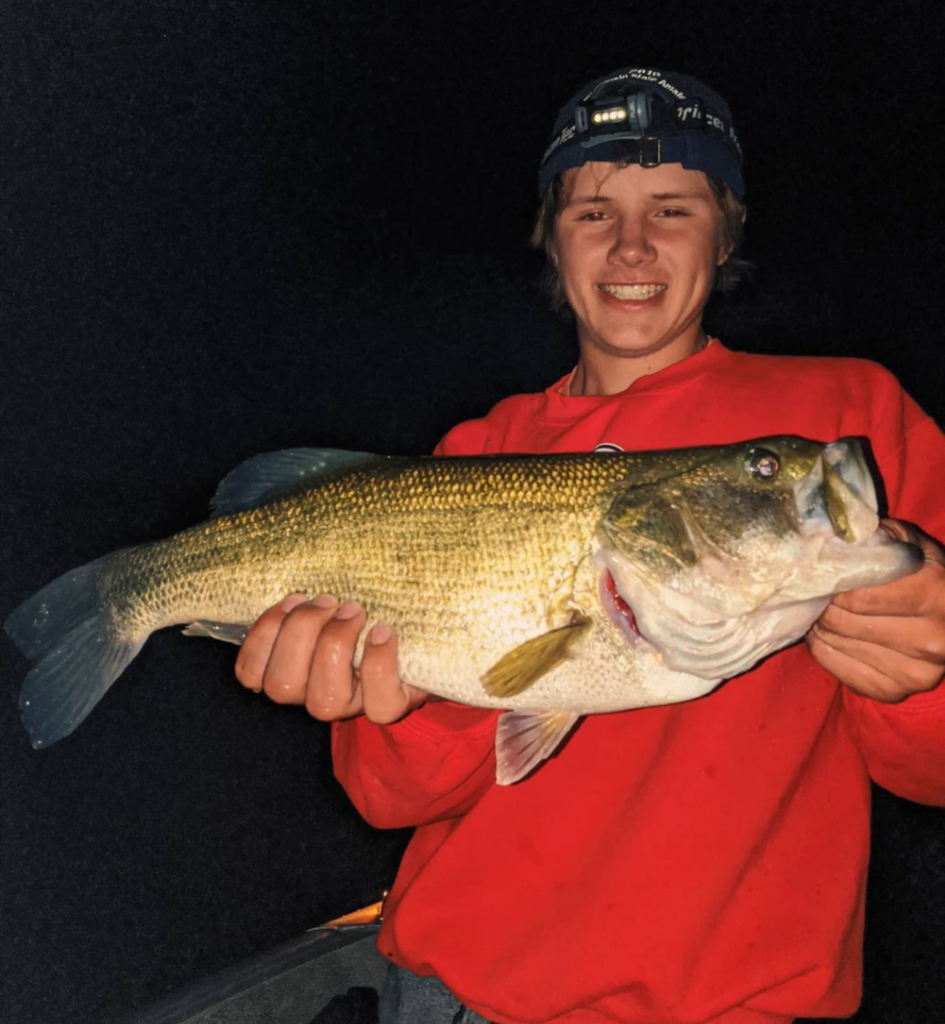
Calm Winds
Wind can be a nemesis to fishing with topwater lures. Not that it has to be perfectly calm, but heavy winds can make fishing with a topwater lure almost impossible. Big waves make it difficult to effectively work your topwater lure, let alone the fact that bass have a much more difficult time honing in on your presentation. Focus on using topwater when the surface is relatively calm for the best chances of success.
Overcast Days
Overcast days tend to indicate a falling barometric pressure a lot of the times. As barometric pressure drops, bass move towards shallower areas and become easier to target with topwater lures. Additionally, bass aren’t as buried in cover on overcast days and are more willing to strike lures on the surface.
Warmer Water Temperature
Topwater fishing works best when the water temperature is warmer. If you think about it, bass have to swim pretty far to strike your lure on the surface. During colder months they just simply aren’t as willing do to this. Adhere your presentation to the water temperature that you will be fishing. If the temperature is on the cooler side, focus on slower moving topwater’s and incorporate longer pauses. When the water temperature is near its peak, try using aggressive topwater’s that move quickly across the surface.
Essential Topwater Bass Fishing Gear
Topwater fishing is one of those techniques that requires specialized gear. The three main pieces of equipment that you’ll need are an appropriate rod, reel, and fishing line setup.
Rod and Reel
When topwater fishing for bass, baitcasting rods and reels are your friend. If you plan on fishing extremely lightweight and finesse topwater lures, look into the bait finesse system. Otherwise, I recommend a medium power rod for treble hooked baits and heavy power rod for jig hooked baits. I often opt for rods between 6’6″ and 7′ is length, but choose a length that feels most comfortable to you. The shorter length makes working topwater lures significantly more manageable. As far as reels go, choose one that you like. If you plan on fishing heavy cover with jig hooked style topwater’s, consider getting a beefed up baitcasting reel with a strong drag system. If not, any baitcasting reel will do the trick.
Best Fishing Line For Topwater
The two main lines for topwater fishing are braided line and monofilament line. The reason behind this is that braid and monofilament float, while fluorocarbon sinks. When fishing topwater, you’ll benefit from a floating line. To keep it simple, use monofilament when fishing treble hooked baits and braid for jig hooked baits. Depending on the size of lure and caliber of fish you are targeting, a monofilament between 10-20 lb test will work. For braided line, anywhere from 30 lb to 65 lb is a good starting point due to its smaller line diameter.
Topwater Lures For Bass
Now that you’re geared up with the correct equipment, let’s talk about what to tie on to the end of your rod.
Hollow Body Frogs
Hollow body frogs are a great option when fishing floating vegetation or heavy cover. A heavy power baitcasting rod and braided line is required to fish this lure effectively. Focus on shallow water with frogs and fish it in and around the thickest cover that you can find. The top jig hook design prevents this lure from snagging, making it one of the most weedless topwater bass lures available. With this hook system, a serious hookset is required to compress the hollow body and drive these big hooks home. Use a walk-the-dog or twitch and pause retrieve for this lure.
Poppers
I think of poppers as a sort of finesse way of fishing topwater. Poppers are incredibly versatile and allow you to effectively fish a variety of water temperatures and locations. Use a twitch and pause retrieve for this lure and experiment with the cadence. For cooler water, give a much longer pause and allow the ripples to dissipate before popping the lure again. For warmer warmer, work the lure quicker and shorten the pauses to adhere to more aggressive fish. Focus on fishing poppers near visible cover since it does not cover much water very quickly. Poppers are treble hooked baits, so I recommend monofilament line for this lure.
Walking Baits
Walking baits are topwater lures specifically designed for the walk-the-dog retrieve. These style of lures have a side to side action and allow you to fish relatively quicker and cover a lot of water. For this reason, focus on fishing walking baits on expansive flats or other large pieces of structure. Walking baits have treble hooks, making monofilament my go-to line for this lure.
Buzzbaits
Buzzbaits are basically a topwater version of the spinnerbait. This lure has a large propellor style of blade which displaces a lot of water and creates lots of noise. Unlike the other topwater lures listed, buzz baits sink when you cast them out. For this reason, use a quick and steady retrieve with your rod tip up to keep this lure on the surface. Make sure the blade is constantly spinning on the surface, you’ll know when you get it right. As you can probably see by know, the buzzbait is a very aggressive lure and works best when the water temperature is warm. Additionally, buzzbaits are one of the best lure options for night fishing due to the loud nature of the bait.
Mastering Topwater Retrieves
Now you have the lures, lets talk about how to retrieve them effectively
Walk The Dog
The walk the dog retrieve is a retrieve that requires appropriate timing to pull off. Use short constant twitches with your rod tip facing down. Time your twitches so that each time the lure changes direction in the water. When you get it right, your lure should move side-to-side through the water.
Twitch and Pause
The twitch and pause retrieve is slightly different than walking the dog since it doesn’t require the same cadence. Simply twitch your rod with your rod tip facing downwards and let the lure sit still. Mix up the number of twitches that you do before letting the bait sit to find what works. Additionally, try longer pauses when the fish are finicky or the water temperature is colder.
Bonus Tip: Pause the lure in key location where you think bass may be positioned. For example, pause the lure at a pier piling or a void in the weed mat.
Steady Retrieve
The steady retrieve is as simple as it gets. Simply reel the lure in at a constant speed once it hits the water. Keep your rod tip in a neutral or upward position for this retrieve. Typically a steady retrieve is used for topwater lures that have propellors and require constant motion to work effectively such as buzzbaits and whopper ploppers. Experiment with your retrieval speed and find the sweet spot where the propellor turns and looks the most natural in the water.
Location
You have the lures and equipment, but where should you fish with them?
Shallow Weed Flats
Shallow flats are great areas to target bass on the surface. Look for flats that have green vegetation and bass will congregate in these areas. Pay attention to small nuances in the flat they may hold a majority of the fish. For example, if a weed flat has floating raft in the middle of it or a small hump on it, these will be the key areas to focus on.
Visible Cover
When I say visible cover, I mean cover that you can see that extends above the waters surface. This can be logs, piers, cattails, or anything else. When fishing topwater in these locations, opt for a lure that can be fished slowly and paused at the piece of cover. Poppers and hollow body frogs are two great options for visible cover.
Drop-Offs and Transitions
Drop-offs and transitions hold fish at all times of year, so why not fish them with topwater lures. These areas act as a sort of highway for bass and make them very easy to predict. Focus on drop-offs and transitions that occur in shallower water for your best chances of success. Weeds, rocks, submerged timber, or other structure are extremely important to look for as well in these locations.
Adapting to Lake Specifics
Not all bodies of water are created equal, so make sure to adapt your topwater techniques to your home lake.
Matching The Hatch
Find out what the bass in your lake are feeding on, and use a lure that best imitates that forage. For example, if your bass are feeding on shiners or other baitfish, a fast moving walking bait may be the best option. If your bass feed primarily on frogs, a hollow body frog seems like a logical choice. Don’t get caught up too much by color, as long as it is close it’ll work just fine.
Experimenting With Retrieves and Cadences
As always, constantly experiment with your retrieve to find what the bass want on a given day. For whatever reason, some days they want a lure to be paused for 10 seconds while other days they may want it as fast as you can reel it in. Don’t get caught up fishing the same way if its not working.
Water Clarity
Pay attention to the water clarity of the body of water you are fishing. When fishing in dirty water, choose more aggressive topwater lures that create lots of vibrations and surface disturbances. Choose bold colors that stand out in the water and enable bass to see it. In clear water, opt for a more subtle approach with a lure that is quieter. Translucent colors can work to your advantage in these types of lakes and prevent bass from getting too good of a look at your lure.
Conservation and Ethical Fishing Practices
As responsible anglers, it’s crucial to prioritize conservation and practice ethical fishing

Catch and Release
Adhere to catch-and-release guidelines whenever possible to preserve the bass population for future generations. Handle fish with care, use barbless hooks to minimize injury, and return them to the water as quickly and gently as possible.
Regulations and Limits
Stay informed about local fishing regulations and adhere to size and bag limits. These limits are in place to ensure sustainable fish populations and healthy ecosystems. Ignorance is no excuse, so take the time to familiarize yourself with the specific regulations in the areas you fish.
Leave No Trace
Respect fish and wildlife habitats by minimizing your impact and leaving the environment as pristine as you found it. Dispose of any trash properly and consider participating in organized shoreline cleanups. Respecting nature and its resources is crucial for future generations of anglers to enjoy.
In the world of bass fishing, few things are as heart-pounding and rewarding as the thrill of topwater action. From identifying when to use topwater lures to the gear essentials and specific lure recommendations, you’re now equipped to topwater fish like a pro. Remember to choose the appropriate style of topwater lure based on the location you plan on fishing and to adhere your presentation to your specific lake. As you embark on your fishing journey, remember that it’s not just about landing the big one – it’s about the connection with nature and the excitement that keeps you coming back for more. So put your newfound knowledge to the test the next time you’re out on the water. Tight Lines!
More Bass Fishing Articles:
